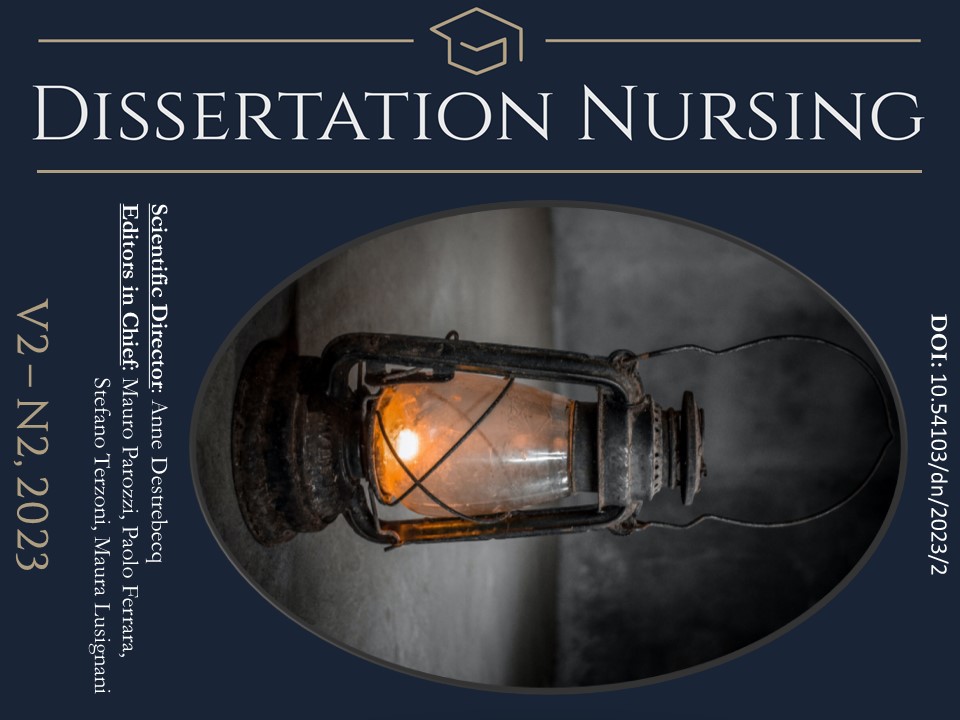Assessing the symptomatic patient affected by COVID-19: the CovidScore scale and the stratification of the clinical risk in sub-intensive units
DOI:
https://doi.org/10.54103/dn/19244Keywords:
COVID-19, NEWS2, assessment, nursing, nurseAbstract
INTRODUCTION: During the pandemic peaks of COVID-19, it was necessary to promptly assess and recognize critical patients early through effective clinical framing supported by specific instruments; therefore, the CovidScore scale was designed, including among its items the specific characteristics of the Sars-CoV-2 patient.
OBJECTIVES: To test whether the CovidScore scale results in better risk framing and stratification than the NEWS2 scale and instrument-free nursing assessment.
MATERIALS AND METHODS: A longitudinal, single-center, prospective study was performed by enrolling 182 patients. Aggregate scores and risk levels defined by CovidScore and NEWS2 were determined through data collected from nurses, who also provided their assessment at intake.
RESULTS: A moderate but statistically significant concordance was found between risk estimated by CovidScore and nurse score (K=0.239.; p<0.00022); between CovidScore and NEWS2, the concordance found was null (K=0.089, p<0.019); low concordance values were found between nurse assessment and NEWS2 (K=0.033, p<0.05).
CONCLUSIONS: The NEWS2 scale seems to underestimate the clinical status of the COVID-19 patient compared with the assessments by CovidScore and nurses. Specific standardized clinical assessment and response systems for the COVID-19 patient, such as the CovidScore scale, could improve the management of large inpatient numbers and positively impact patient outcomes. Further studies with robust methodology are needed to test these hypotheses and strengthen the evidence found.
References
Myrstad M, Ihle-Hansen H, Tveita AA, Andersen EL, Nygård S, Tveit A, et al. National Early Warning Score 2 (NEWS2) on admission predicts severe disease and in-hospital mortality from Covid-19 - A prospective cohort study. Scand J Trauma Resusc Emerg Med. 2020;28(1):1–8.
Coughlan C, Rahman S, Honeyford K, Costelloe CE. Developing useful early warning and prognostic scores for COVID-19. Postgrad Med J. 2021;97(1150):477–80.
Baker KF, Hanrath AT, van der Loeff IS, Kay LJ, Back J, Duncan CJA. National Early Warning Score 2 (NEWS2) to identify inpatient COVID-19 deterioration: A retrospective analysis. Clin Med J R Coll Physicians London. 2021;21(2):84–9.
Semeraro F, Scquizzato T, Scapigliati A, Ristagno G, Gamberini L, Tartaglione M, et al. New Early Warning Score: off-label approach for Covid-19 outbreak patient deterioration in the community. Resuscitation [Internet]. 2020;151:24–5. Available from: https://doi.org/10.1016/j.resuscitation.2020.04.018
Song CY, Xu J, He JQ, Lu YQ. COVID-19 early warning score: A multi-parameter screening tool to identify highly suspected patients. medRxiv. 2020;(March).
De Socio GV, Gidari A, Sicari F, Palumbo M, Francisci D. National Early Warning Score 2 (NEWS2) better predicts critical Coronavirus Disease 2019 (COVID-19) illness than COVID-GRAM, a multi-centre study. Infection [Internet]. 2021;2:3–8. Available from: https://doi.org/10.1007/s15010-021-01620-x
Lopes-Pacheco M, Silva PL, Cruz FF, Battaglini D, Robba C, Pelosi P, et al. Pathogenesis of Multiple Organ Injury in COVID-19 and Potential Therapeutic Strategies. Front Physiol. 2021;12(January):1–23.
Liu Y, Mao B, Liang S, Yang JW, Lu HW, Chai YH, et al. Association between age and clinical characteristics and outcomes of COVID-19. Eur Respir J. 2020;318(6).
Ejaz H, Alsrhani A, Zafar A, Javed H, Junaid K, Abdalla AE, et al. COVID-19 and comorbidities: Deleterious impact on infected patients. J Infect Public Health [Internet]. 2020;13(12):1833–9. Available from: https://doi.org/10.1016/j.jiph.2020.07.014
European Centre for Disease Prevention and Control (ECDC). Risk factors and risk groups [Internet]. Latest evidence. 2020. Available from: https://www.ecdc.europa.eu/en/covid-19/latest-evidence/risk-factors-risk-groups%0Ahttps://www.ecdc.europa.eu/en/covid-19/latest-evidence/epidemiology
Brink A, Alsma J, Verdonschot RJCG, Rood PPM, Zietse R, Lingsma HF, et al. Predicting mortality in patients with suspected sepsis at the Emergency Department; A retrospective cohort study comparing qSOFA, SIRS and National Early Warning Score. PLoS One. 2019;14(1):1–14.
Royal College of Physicians of London. National Early Warning Score (NEWS) : standardising the assessment of acute-illness severity in the NHS. 2012. 29 p.
Chatterjee NA, Jensen PN, Harris AW, Nguyen DD, Huang HD, Cheng RK, et al. Admission respiratory status predicts mortality in COVID-19. Influenza Other Respi Viruses. 2021;15(5):569–72.
FADOI. Guida clinico-pratica COVID 19. 2020;1–123.
Infezione CON. RESPIRATORIA DA COVID-19 Gestione pneumologica.
Hu B, Guo H, Zhou P, Shi ZL. Characteristics of SARS-CoV-2 and COVID-19. Nat Rev Microbiol [Internet]. 2021;19(3):141–54. Available from: http://dx.doi.org/10.1038/s41579-020-00459-7
Centers For Disease Control and Prevention. Basics of Oxygen Monitoring and Oxygen Therapy during the COVID-19 Pandemic. 2020 [Internet]. 2020;2019:1–3. Available from: https://www.cdc.gov/coronavirus/2019-ncov/videos/oxygen-therapy/Basics_of_Oxygen_Monitoring_and_Oxygen_Therapy_Transcript.pdf
Degasperi D, Anestesia UOC, Intensiva T, Cerchiari DE. Indicazioni e modalità d ’ uso. 2013;
Misurazione degli scambi gassosi - Malattie polmonari - Manuali MSD Edizione Professionisti.
Maggiore SM, Idone FA, Vaschetto R, Festa R, Cataldo A, Antonicelli F, et al. Nasal high-flow versus venturi mask oxygen therapy after extubation: Effects on oxygenation, comfort, and clinical outcome. Am J Respir Crit Care Med. 2014;190(3):282–
Beecroft JM, Hanly PJ. Comparison of the OxyMask and Venturi mask in the delivery of supplemental oxygen: Pilot study in oxygen-dependent patients. Can Respir J. 2006;13(5):247–52.
Whittle JS, Pavlov I, Sacchetti AD, Atwood C, Rosenberg MS. Respiratory support for adult patients with COVID‐19. J Am Coll Emerg Physicians Open. 2020;1(2):95–101.
Redazione. Normale o Alta? La Tabella dei Valori Pressori [Internet]. Fondazione Umberto Veronesi; 2014 [cited 2022 Nov]. Available from: https://www.fondazioneveronesi.it/magazine/articoli/cardiologia/normale-o-alta-la-tabella-dei-valori-pressori
Lin HY. The severe COVID-19: A sepsis induced by viral infection? And its immunomodulatory therapy. Chinese J Traumatol - English Ed [Internet]. 2020;23(4):190–5. Available from: https://doi.org/10.1016/j.cjtee.2020.06.002
Chang JC. COVID-19 Sepsis : Pathogenesis and Endothelial Molecular Mechanisms Based on “ Two-Path Unifying Theory ” of Hemostasis and Endotheliopathy- Associated Vascular Microthrombotic Disease , and Proposed Therapeutic Approach with Antimicrothrombotic Therapy. 2021;(June):273–98.
Forrester JD. Sepsi e shock settico - medicina di terapia intensiva [Internet]. Manuali MSD; 2022 [cited 2022 Nov]. Available from: https://www.msdmanuals.com/it-it/professionale/medicina-di-terapia-intensiva/sepsi-e-shock-settico/sepsi-e-shock-settico
Robba C, Battaglini D, Pelosi P, Rocco PRM. Multiple organ dysfunction in SARS-CoV-2: MODS-CoV-2. Expert Rev Respir Med [Internet]. 2020;14(9):865–8. Available from: https://doi.org/10.1080/17476348.2020.1778470
Huang C, Wang Y, Li X, Ren L, Zhao J, Hu Y, et al. Clinical features of patients infected with 2019 novel coronavirus in Wuhan, China. Lancet. 2020;395(10223):497–506.
Dennison Himmelfarb CR, Baptiste D. Coronavirus Disease (COVID-19). Vol. 35, Journal of Cardiovascular Nursing. 2020. p. 318–21.
Nanshan Chen 1 , Min Zhou 2 , Xuan Dong 1 , Jieming Qu 2 , Fengyun Gong 3 , Yang Han 4 , Yang Qiu 5 , Jingli Wang 3 , Ying Liu 6 , Yuan Wei 1 , Jia’an Xia 1 , Ting Yu 1 , Xinxin Zhang 7 LZ. IKKE BRUG Epidemiological and Clinical Characteristics of 99 Cases of 2019 Novel Coronavirus Pneumonia in Wuhan, China: A DescriptNanshan Chen 1 , Min Zhou 2 , Xuan Dong 1 , Jieming Qu 2 , Fengyun Gong 3 , Yang Han 4 , Yang Qiu 5 , Jingli Wang 3 , Ying Li. Lancet. 2020;395(10223):507–13.
Salah HM, Mehta JL. Hypothesis: Sex-Related Differences in ACE2 Activity May Contribute to Higher Mortality in Men Versus Women With COVID-19. J Cardiovasc Pharmacol Ther. 2021;26(2):114–8.
Briguglio M, Crespi T, Pino F, Mazzocchi M, Porta M, De Vecchi E, et al. Clinical Characteristics of Severe COVID-19 Patients Admitted to an Intensive Care Unit in Lombardy During the Italian Pandemic. Front Med. 2021;8(March):1–6.
GIMBE. Pandemia Coronavirus | GIMBE | Italia [Internet]. 2020. Available from: https://coronavirus.gimbe.org/emergenza-coronavirus-italia.it-IT.html%0Ahttps://coronavirus.gimbe.org/
COVID-19_ le caratteristiche degli italiani ricoverati in rianimazione, raccontate su JAMA - Policlinico Universitario A.
Gibson PG, Qin L, Puah SH. COVID-19 acute respiratory distress syndrome (ARDS): clinical features and differences from typical pre-COVID-19 ARDS. Vol. 213, Medical Journal of Australia. 2020. p. 54-56.e1.
Ranieri VM, Rubenfeld GD, Thompson BT, Ferguson ND, Caldwell E, Fan E, et al. Acute respiratory distress syndrome: The Berlin definition. JAMA - J Am Med Assoc. 2012;307(23):2526–33.
Patel BK. Insufficienza respiratoria acuta ipossiemica (insufficienza respiratoria acuta ipossiemica, sindrome da distress respiratorio acuto) [Internet]. Manuali MSD Edizione Professionisti. 2023. Available from: https://www.msdmanuals.com/it-it/professionale/medicina-di-terapia-intensiva/insufficienza-respiratoria-e-ventilazione-meccanica/insufficienza-respiratoria-acuta-ipossiemica-insufficienza-respiratoria-acuta-ipossiemica,-sindrome-da-distress-respiratorio-acuto
Royal College of Physicians. National Early Warning Score ( NEWS ) - Additional Implementation Guidance. 2020;(March):47. Available from: https://www.rcplondon.ac.uk/projects/outputs/national-early-warning-score-news
Kostakis I, Smith GB, Prytherch D, Meredith P, Price C, Chauhan A, et al. The performance of the National Early Warning Score and National Early Warning Score 2 in hospitalised patients infected by the severe acute respiratory syndrome coronavirus 2 (SARS-CoV-2). Resuscitation. 2021 Feb;159:150–7..
Downloads
Published
How to Cite
Issue
Section
License
Copyright (c) 2023 Filippo Capone, Ana Karina Hinojosa, Alessia Gant, Sara Dentice

This work is licensed under a Creative Commons Attribution-NonCommercial-NoDerivatives 4.0 International License.
Accepted 2023-04-05
Published 2023-07-31











